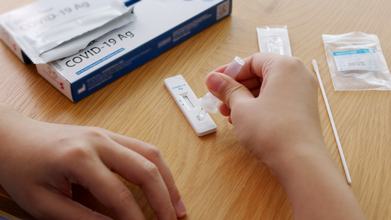- Health Conditions A-Z
- Health & Wellness
- Nutrition
- Fitness
- Health News
- Ayurveda
- Videos
- Medicine A-Z
- Parenting
CDC Plans Vaccine-Autism Study Despite Scientific Consensus

Credits: Canva
Ever since Trump has taken over the President's office in the United States, a lot has changed. Up new is the new study that the Centers for Disease Control and Prevention (CDC) is planning to examine potential link between vaccines and autism. This has all come up in the backdrop of the claims by the now Health and Human Services (HHS) Secretary Robert F Kennedy Jr, who has suggested the link between vaccines and autism. This has been backed by President Trump as well.
The Origin Of This Theory
Even if it is a rumor, it can be traced. So is the case for this theory, which connects vaccines with autism. This originated from now debunked 1998 study, which was retracted after its author, Andrew Wakefield, was found guilty of professional misconduct and barred from practicing medicine in the UK. Despite decades or research no such link could be proven, however, the claim still continues in the political and public discourse.
Kennedy, who had long been anti-vaxxer, also made numerous claims, even though studies have long debunked this theory.
The insights research offers
The number of autism diagnoses in the United States has increased over the years. According to CDC data, about 1 in 36 children have been diagnosed with autism, compared to 1 in 150 in the year 2000. Experts attribute this rise largely to improved awareness, broader diagnostic criteria, and genetic and environmental factors rather than vaccines.
Many yeas of extensive study has shown that there is no real connection between vaccines and autism. As per a 2019 study, which was conducted over a decade in Denmark, involving half a million children, confirmed that the measles, mumps and rubella (MMR) vaccine does not increase any risk of autism. Other studies too have confirmed the same, being studied over large sample sizes. It had reinforced the medical consensus that vaccines are safe and essential for public health.
Public health experts have expressed concerns about the CDC’s decision to allocate resources toward a study on an already well-researched and resolved issue. Critics argue that taxpayer dollars should be directed toward more pressing public health concerns, including understanding the actual causes of autism and improving support for individuals on the spectrum. Experts warn that re-examining this debunked theory may fuel vaccine hesitancy, undermining public trust in immunization programs.
Data Monitoring
The study will apparently employ data from the CDC's Vaccine Safety Datalink (VSD), a long-standing system for monitoring vaccine safety and discovering rare adverse events. The CDC's Immunisation Safety Office works with healthcare providers around the country to examine electronic health data for vaccine safety assessments. However, public health professionals have questioned the initiative, stating that the link between vaccinations and autism has already been thoroughly investigated.
Many medical professionals and health organizations, including the American Academy of Pediatrics and the American Public Health Association, have voiced concerns that revisiting this baseless claim could mislead the public. They stress that resources should focus on understanding autism's complex causes and enhancing support systems rather than re-examining a theory that has been conclusively debunked.
The CDC has yet to officially announce the study, but experts remain vigilant, warning against any efforts that could contribute to public confusion and vaccine hesitancy.
WHO Approves Two COVID-19 Rapid Antigen Tests, Check The Details Here

Credits: iStock
The World Health Organization (WHO) on December 24 prequalified two rapid antigen diagnostic tests (Ag-RDTs) for SARS-CoV-2. This virus is known to have caused COVID-19. As per the WHO, these two tests are called SD Biosensor STANDARD Q COVID-19 Ag Test and the ACON Biotech Flowflex SARS-CoV-2 Antigen Rapid Test (Self-Testing).
At first these tests got temporary emergency approval from the WHO during the pandemic. This was done so the countries could start using them quickly even though long-term data was limited. This emergency approval helped the tests reach over 100 countries when they were urgently needed.
What Has Changed Now?
The WHO has now given these tests full prequalification, which means it has a stronger and long-term approval. This means that the WHO has thoroughly checked and confirmed that the tests consistently meet global standards for quality, safety, and accuracy.
Why Does This Matter?
- The tests can now be officially bought and used by global organizations and governments
- They can be included in bulk purchasing to lower prices and increase supply
- This makes reliable COVID-19 testing more affordable and accessible, especially in low-and middle-income countries
COVID-19 Is Far From Being Over
Even though WHO officially ended COVID-19 emergency phase over two years ago, the virus is still circulating globally. In fact, this year, we have seen variants of COVID-19 circulating around, causing the most unique symptoms, including razor-blade like throat. Variants like JN.1, Stratus, Nimbus, LP8.1, and BA.3.2 were all that we saw in 2025.
While the good news is that infection levels are relatively stable, but the virus has not completely disappeared and testing is still necessary, especially in poorer countries.
Many low-income countries do not have easy access to labs or expensive PCR testing. So there is still a need for a strong, but cheaper and reliable way to detect COVID-19, and these tests may as well do that.
Why Rapid Antigen Test Matters
- Give results in 15–30 minutes
- Cost less than PCR tests
- Don’t require labs or specialized equipment
- This means they can be used in small clinics, community centers, mobile vans, or remote areas, where lab testing isn’t practical.
However, it is important to note that rapid antigen tests are not replacement for PCR tests. They simply complement the PCR tests by allowing faster, on-the-spot decisions, especially when the lab capacity is limited.
What Makes It Essential Today?
Rapid antigen tests could help with spotting and stopping local outbreaks quickly, protecting high-risk people and healthcare workers, and staying prepared for future respiratory pandemics.
The WHO is also pushing for decentralized, quality-checked testing as part of universal healthcare and global health security, so countries aren’t caught unprepared when the next outbreak happens.
When Is It A Right Time To Get Yourself Checked For COVID-19?
If you notice these following symptoms as noted by the Centers for Disease Control and Prevention (CDC), it is best that you get yourself a COVID-19 test:
- Fever or chills
- Cough
- Shortness of breath or difficulty breathing
- Sore throat
- Congestion or runny nose
- New loss of taste or smell
- Fatigue
- Muscle or body aches
Singapore, UK and Canada Issue Health Advisory Over Delhi’s Air Pollution

Credits: iStock
As Delhi's air quality levels and pollution continues to worsen, and people struggle to breathe, countries like Singapore, the United Kingdom, and Canada issued advisories for their citizens travelling to the capital city. However, the capital city's crisis continues to remain ignore, though CM Rekha Gupta did hold a review meeting on the same on Monday, with a follow-up scheduled on Thursday.
Singapore Travel Advisory On Delhi's Air Pollution
Singapore High Commission issued an advisory, which stated:
On 13 December 2025: The Indian Central Pollution Control Board invoked Stage 4, the highest level, of the Graded Response Action Plan (GRAP) in the Delhi National Capital Region. Under GRAP 4, construction and industrial activities are heavily restricted, and schools and offices are encouraged to shift to hybrid format. The Delhi authorities have urged residents to stay indoors, especially children and those with respiratory or cardiac ailments, and to use masks if stepping out. In this regard, the High Commission urges Singapore nationals in the Delhi National Capital Region to pay heed to this advice.
We also note that given the low visibility, flights to and from the Delhi National Capital Region are likely to be affected. The Indira Gandhi International Airport and several airlines have issued advisories. Travellers should take note of this, and check with the respective airlines for updates.
UK And Canada Too Issue Advisories On Delhi Pollution And Its Impact On People
UK's Foreign, Commonwealth & Development Office (FCDO) warned that air pollution could lead to serious health threats for those living in northern India, especially between the months of October and February. The UK advisory also stressed on the health of pregnant women and people with any heart or respiratory. The advisory noted that they must seek medical advice before travelling to India.
The statement read: Children, the elderly and those with pre-existing medical conditions may be especially affected. If you’re pregnant or have a respiratory or heart condition you may wish to consult a medical practitioner before you travel.
Canada too issued a similar notice, advising, especially those who are already struggling with respiratory issues and to continuously monitor air quality levels. The notice also highlighted the pollution that is caused by fog and smoke trends that are increasing in urban areas like Delhi, especially during the winters.
The advisory read: Smoke haze and other types of air pollution can be extremely hazardous in urban areas and cities such as Delhi. It’s typically at its worst in winter. In rural areas, air quality can be affected by agricultural burning. Dust storms also occur across northern India. Monitor air pollution levels, which change quickly, especially if you suffer from respiratory ailments or have pre-existing medical conditions.
As of today, Delhi's air quality remained in "very poor" category, and the AQI stood at 342 at 8am, as per the Central Pollution Control Board. The 24-hour average AQI was logged at 412 under the "severe" category on Tuesday evening when Delhi's quality peaked to record the fourth severe air day in the month of December.
2 Dead, 21 Injured After Pennsylvania Nursing Home Catches Fire

Source: Parkland Fire Company
A Pennsylvania nursing home caught on fire due to an apparent gas explosion. The Silver Lake Nursing home in Pennsylvania's Bristol Township caught on fire, and videos show flames erupting from the building, and debris scattered around the area. The Pennsylvania Governor Josh Shapiro confirmed the that there are so far two deaths, with 21 people found injured. Many have been rescued, yet rescuers believe that five people are unaccounted for.
What Happened At The Silver Lake Nursing Home?
At 2.15pm is when the flames could be seen from the gas-related explosion. PECO confirmed that crew had started to respond around 2pm itself after they received reports of a gas odor. The explosion had occurred when the crew were on the scene.
“While crews were on site, an explosion occurred at the facility. PECO crews shut off natural gas and electric service to the facility to ensure the safety of first responders and local residents,” the utility said in a the statement.
State Rep. Tina Davis told the Associated Press. "I saw smoke and I saw car after car after car was a fire truck or ambulance from all over the city, from all over."
Davis says that there were talks of using a nearby school as a temporary evacuation area.
How Are Burn Injuries Treated?
Burn injuries are first classified before the treatment. Their classification decides the treatment the burn will require. There are for classifications of burns:
First-degree or superficial burns: They only affect the outer layer of the skin or the epidermis. In these injuries, the burn site is red, painful, dry, and has no blisters.
Second-degree or partial thickness burns: They are only the burns of epidermis and part of the lower layer of the skin, the dermis. The burn site looks red and blistered and may be swollen and painful.
Third-degree or full thickness burns: Third-degree burns destroy the epidermis and dermis. They could also go to the innermost later of the skin, the subcutaneous tissue. The burn site could look white or blackened and charred.
Fourth-degree burns: They burn through both layers of the skin and underlying tissue as well as deeper tissue, and could possibly reach muscle and bone. There is no feeling in the area since the nerve endings are destroyed.
The right way to treat a burn depends on its depth and how much of the body it covers. While minor, superficial burns can be managed at home, deeper or larger burns may need medical attention. Keep these essential guidelines in mind:
Do's:
- Remove the source of the burn immediately – For example, take off clothing soaked in hot liquid to prevent further damage.
- Run cool water over the burn – This helps soothe the skin, except in cases of certain chemical burns.
- Keep the burn clean and protected – Cover it with a clean, non-stick bandage when possible.
- Seek medical help – If the burn is deeper than a superficial layer, larger than your hand, or full-thickness, see a doctor.
Don’ts:
- Use home remedies like bleach or butter – These can make the burn worse.
- Apply ointments or creams on deep burns – They can trap heat and worsen the injury.
- Put ice on the burn – It can cause more damage to the skin.
- Pop blisters – This increases the risk of infection.
© 2024 Bennett, Coleman & Company Limited

